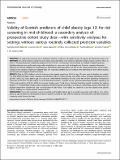Files in this item
Validity of Scottish predictors of child obesity (age 12) for risk screening in mid-childhood : a secondary analysis of prospective cohort study data—with sensitivity analyses for settings without various routinely collected predictor variables
Item metadata
| dc.contributor.author | Carrillo-Balam, Gabriela | |
| dc.contributor.author | Doi, Lawrence | |
| dc.contributor.author | Marryat, Louise | |
| dc.contributor.author | Williams, Andrew James | |
| dc.contributor.author | Bradshaw, Paul | |
| dc.contributor.author | Frank, John | |
| dc.date.accessioned | 2022-06-06T16:30:02Z | |
| dc.date.available | 2022-06-06T16:30:02Z | |
| dc.date.issued | 2022-09-01 | |
| dc.identifier | 279726432 | |
| dc.identifier | 60e7c21e-ef7a-442f-9bd5-e0be185e852e | |
| dc.identifier | 85131324192 | |
| dc.identifier | 000805705200001 | |
| dc.identifier.citation | Carrillo-Balam , G , Doi , L , Marryat , L , Williams , A J , Bradshaw , P & Frank , J 2022 , ' Validity of Scottish predictors of child obesity (age 12) for risk screening in mid-childhood : a secondary analysis of prospective cohort study data—with sensitivity analyses for settings without various routinely collected predictor variables ' , International Journal of Obesity , vol. 46 , no. 9 , pp. 1624–1632 . https://doi.org/10.1038/s41366-022-01157-5 | en |
| dc.identifier.issn | 0307-0565 | |
| dc.identifier.other | ORCID: /0000-0002-2175-8836/work/114335930 | |
| dc.identifier.uri | https://hdl.handle.net/10023/25492 | |
| dc.description | Funding: The authors acknowledge the generosity of the funders of this work, the Children’s Data Collaborative – a consortium of the Scottish Government, Data-Driven Initiative, UNICEF, and the University of Edinburgh. Additional salary support is gratefully acknowledged for LM’s/LD’S/AJW’s contributions to this work, from (respectively): LM -- School of Health Sciences, University of Dundee; LD -- School of Health in Social Science, University of Edinburgh; AJW -- School of Medicine, University of St Andrews. | en |
| dc.description.abstract | Objective : To analyse the Growing Up in Scotland cohort for predictors of obesity at age 12, present at school entry (age 5-6). Methods : The initial model included literature-based risk factors likely to be routinely collected in high-income countries (HICs), as well as “Adverse/Protective Childhood Experiences (ACEs/PCEs)”. Missing data were handled by Multiple Chained Equations. Variable-reduction was performed using multivariable logistic regression with backwards and forwards stepwise elimination, followed by internal validation by bootstrapping. Optimal sensitivity/specificity cut-offs for the most parsimonious and accurate models in two situations (optimum available data, and routinely available data in Scotland) were examined for their referral burden, and Positive and Negative Predictive Values. Results : Data for 2787 children with full outcome data (obesity prevalence 18.3% at age 12) were used to develop the models. The final “Optimum Data” model included six predictors of obesity: maternal body mass index, indoor smoking, equivalized income quintile, child’s sex, child’s BMI at age 5-6, and ACEs. After internal validation, the area under the receiver operating characteristic curve was 0.855 (95% CI 0.852-0.859). A cut-off based on Youden’s J statistic for the Optimum Data model yielded a specificity of 77.8% and sensitivity of 76.3%. 37.0% of screened children were “Total Screen Positives” (and thus would constitute the “referral burden”.) A “Scottish Data” model, without equivalized income quintile and ACEs as a predictor, and instead using Scottish Index of Multiple Deprivation quintile and “age at introduction of solid-foods,” was slightly less sensitive (76.2%) but slightly more specific (79.2%), leading to a smaller referral burden (30.8%). Conclusion : Universally collected, machine-readable and linkable data at age 5-6 predict reasonably well children who will be obese by age 12. However, the Scottish treatment system is unable to cope with the resultant referral burden and other criteria for screening would have to be met. | |
| dc.format.extent | 9 | |
| dc.format.extent | 824460 | |
| dc.language.iso | eng | |
| dc.relation.ispartof | International Journal of Obesity | en |
| dc.subject | Child obesity | en |
| dc.subject | Screening | en |
| dc.subject | Epidemiology | en |
| dc.subject | Scotland | en |
| dc.subject | Overweight | en |
| dc.subject | Body Mass Index | en |
| dc.subject | Growing Up in Scotland study | en |
| dc.subject | RA0421 Public health. Hygiene. Preventive Medicine | en |
| dc.subject | RJ Pediatrics | en |
| dc.subject | E-DAS | en |
| dc.subject | SDG 3 - Good Health and Well-being | en |
| dc.subject | MCC | en |
| dc.subject.lcc | RA0421 | en |
| dc.subject.lcc | RJ | en |
| dc.title | Validity of Scottish predictors of child obesity (age 12) for risk screening in mid-childhood : a secondary analysis of prospective cohort study data—with sensitivity analyses for settings without various routinely collected predictor variables | en |
| dc.type | Journal article | en |
| dc.contributor.institution | University of St Andrews. School of Medicine | en |
| dc.contributor.institution | University of St Andrews. Population and Behavioural Science Division | en |
| dc.identifier.doi | https://doi.org/10.1038/s41366-022-01157-5 | |
| dc.description.status | Peer reviewed | en |
This item appears in the following Collection(s)
Items in the St Andrews Research Repository are protected by copyright, with all rights reserved, unless otherwise indicated.

